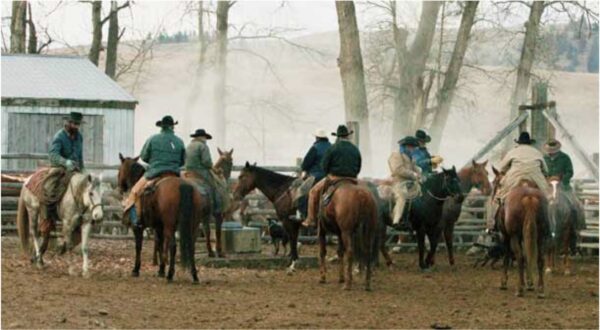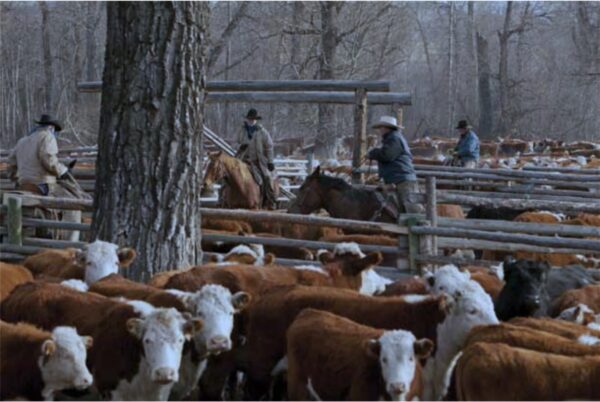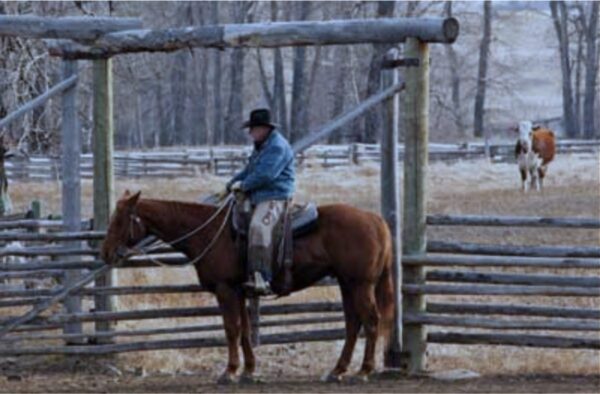Legendary Cow Boss
By Haley Rutherford originally published in October/November Canadian Cowboy Country Magazine
Legends aren’t born, but are a product of both circumstance and the environment in which they live. And as such, a true legend would never lay claim to the title, but simply do what he has to do to get the job done. But people are like the Earth’s rocks—under immense pressure, some crumble, while others turn into a gem.

The pressures of running Canada’s largest (and arguably, most legendary) ranch would undoubtedly feel just as heavy some days — overseeing the horses and men that it takes to successfully manage 7,000 mother cows in the rugged country of B.C. So it seems natural that Stan Jacobs, Douglas Lake’s cow boss of more than twenty years, would have to be somewhat of a legendary character himself.
Stan never set out to be a cowboy. Born in Calgary, Stan is the son of a carpenter, Fred Jacobs. Originally from Halifax, Fred and Bonnie Jacobs moved to Alberta after World War II and started a family. It is actually his mother to whom Stan gives credit for instilling in him a passion for ranching and the outdoors.
For a short time the Jacobs’ lived in Calgary, then moved to an acreage near DeWinton when Stan was young. Here he spent much of his time trapping, fishing and hunting. After graduating high school, Stan applied to college in Hinton to become a park warden. This was before wardens had ATV’s and pickups; instead they were given a pack string and supplies to keep them in the bush until the snow. As fate would have it, the school was full and Stan decided to try his hand at cowboying.
After working for Alberta Live- stock Transplants for a few years, Stan moved to the Nicola Valley. He had been out to the area to visit his buddy, Tim O’Byrne, who was on the Nicola Ranch and he decided that it was somewhere he wanted to work. He signed on in the fall of 1980. He laughs as he recalls the attitude of his younger years—“Bob Munsey told me one time that it takes 10 years of workin’ before a guy can call himself a cowboy. I was pretty shocked at that; at the time I had been working for five or six years and thought myself a pretty good hand. Ten years sure seemed like a long time.”
It was during his time on the Nicola that Stan met and married his wife, Shirley (McCreight). While living up at the Voght Valley division, the young family, which now included children Cameron and Megan, decided to make the move to the Douglas Lake Ranch.

Hiring on at the Douglas Lake set the stage for Stan to become synonymous with the ranch name. He was working at the Douglas Lake calving barn when Duncan Barnett, the assistant manager at the time, called him into the office.
“Joe Gardner and Mike Ferguson were there,” Stan recalls, “and they told me I had the job of cowboss if I wanted it. I told them I would have to think about it.” Of the promotion, Stan never assumed that he would fit that mold. He claims, “If that job had been advertised, I never would have applied for it.”
Although he cherishes tradition, as he got into his new job Stan realized that change was imminent and the ranch had two choices: they could either lead or follow. Like his former Nicola boss, Keith Smith, describes, “The tougher things get, the harder Stan works and strives.” As a result, Stan didn’t let ego steer him away from getting off his horse and sitting behind a desk to learn to run a computer, and although he doesn’t enjoy it, he realizes that it’s a necessity and he has developed spreadsheets to track bull pedigrees and costs.
Yet he still sees the cattle industry clearest from the back of a horse. This balance between riding- the-pine and being horseback has allowed him to build a herd of some of the best cows in the country. This also fits into his philosophy of “completeness.” Whether it’s cattle or horses, Stan doesn’t focus on just one trait. He credits Ray van Steinburg, a purebred breeder from Pine Butte Ranch, for teaching him this.
“Ray taught me that if you get a complete animal, then you’ll hit the tops on everything.”
He says that although he may look at EPDs (Expected Progeny Differences) when buying bulls, they aren’t the criteria. Instead he likes to focus on pedigrees and the look of the animal.

his shoulder and walked about 5 miles up the fence line clearing brush. He won’t ask someone to do something he wouldn’t — he leads by example. He’s a hardworking man and I doubt if there’s any tougher.”
“What’s good for us may be bad for someone else,” he explains, “but, the bottom line of my job is to grow grass; the cows harvest this grass so that the ranch can make a living. I need a cow that is going to be able to graze 10 months of the year and raise a good calf. Steers are a by-product of what we do. We need to be able to raise a cow that works for us.” This success is why, a few years ago, Stan was awarded the title of Canadian Stockman of the Year at the National Western Stock Show in Denver, Colorado.
Titles and awards have never meant much to this cowboy. As long-time friend Keith Smith says, “There is not one difference in the person that he is today than the one I met in 1980. His greatest quality is his own person. He has never wanted to be recognized by his accomplishments or position, but instead by who he is.”
And, although I’m sure he has buckaroo tales a-plenty, like a true living legend, Stan doesn’t say too much about himself. “I don’t fancy myself a horse trainer,” he says. “Sure I’ve had some good horses, but horses are a mode of transportation to take care of the cows, and the cows are how I harvest the grass. Grass is how this ranch makes money.”

His loyalty to the outdoors and the health of the ranch is evident.
“Like I’ve told the last two owners (of Douglas Lake), your name may be on the title, but I own this place more than you ever will. I’m the one that gets to work here and enjoy it.”
Haley Rutherford’s family ranches in the Nicola Valley. She currently lives and works in Alberta.
Photo’s courtesy Kim Taylor/Slidin’ U Photography












